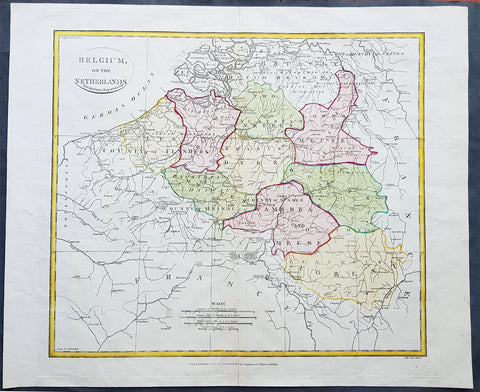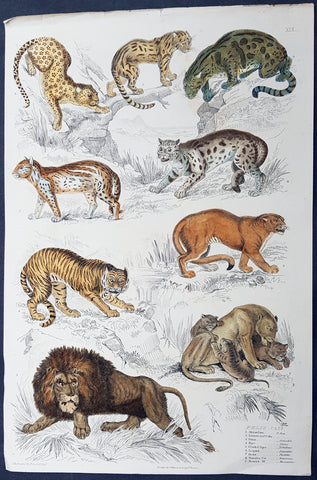Samuel Neele
1808 Samuel Neele Large Antique Map of Belgium & Southern Netherlands
- Title : Belgium or the Netherlands divided into Departments
- Date : 1808
- Condition: (A+) Fine Condition
- Ref: 24329-1
- Size: 20in x 16in (510mm x 405mm)
Description:
This beautifully hand coloured original antique map of Belgium & the southern Netherlands was engraved by John Neele in 1808 - the date is engraved at the foot of the map - and published in the 1810 edition of The Modern Royal Atlas. (Ref: Tooley; M&B)
General Definitions:
Paper thickness and quality: - Heavy and stable
Paper color : - off white
Age of map color: - Original
Colors used: - Yellow, Green, pink
General color appearance: - Authentic
Paper size: - 20in x 16in (510mm x 405mm)
Plate size: - 16½in x 15in (420mm x 380mm)
Margins: - Min 1in (25mm)
Imperfections:
Margins: - Light creasing
Plate area: - Light creasing, light wear along bottom centerfold
Verso: - None
Background:
The name Belgium is derived from Gallia Belgica, a Roman province in the northernmost part of Gaul that before Roman invasion in 100 BC, was inhabited by the Belgae, a mix of Celtic and Germanic peoples. A gradual immigration by Germanic Frankish tribes during the 5th century brought the area under the rule of the Merovingian kings. A gradual shift of power during the 8th century led the kingdom of the Franks to evolve into the Carolingian Empire.
The Treaty of Verdun in 843 divided the region into Middle and West Francia and therefore into a set of more or less independent fiefdoms which, during the Middle Ages, were vassals either of the King of France or of the Holy Roman Emperor.
Many of these fiefdoms were united in the Burgundian Netherlands of the 14th and 15th centuries. Emperor Charles V extended the personal union of the Seventeen Provinces in the 1540s, making it far more than a personal union by the Pragmatic Sanction of 1549 and increased his influence over the Prince-Bishopric of Liège.
The Eighty Years\' War (1568–1648) divided the Low Countries into the northern United Provinces (Belgica Foederata in Latin, the Federated Netherlands) and the Southern Netherlands (Belgica Regia, the Royal Netherlands). The latter were ruled successively by the Spanish (Spanish Netherlands) and the Austrian Habsburgs (Austrian Netherlands) and comprised most of modern Belgium. This was the theatre of most Franco-Spanish and Franco-Austrian wars during the 17th and 18th centuries.
Following the campaigns of 1794 in the French Revolutionary Wars, the Low Countries—including territories that were never nominally under Habsburg rule, such as the Prince-Bishopric of Liège—were annexed by the French First Republic, ending Austrian rule in the region. The reunification of the Low Countries as the United Kingdom of the Netherlands occurred at the dissolution of the First French Empire in 1815, after the defeat of Napoleon.
Neele, Samuel John 1758–1824
Samuel John Neele was a cartographer, copper-plate engraver and printer with business in the Strand, London.
Also father of Henry Neele the English poet and literary scholar.
1825 Captain Thomas Brown Antique Print of Cats - Lions, Puma, Tiger, Leopard...
- Title : Felix Cats
- Date : 1825
- Condition: (A+) Fine Condition
- Ref: 90647
- Size: 13 1/2in x 9in (345mm x 230mm)
Description:
This beautiful large original hand coloured copper-plate engraved antique print of various cats (Felix), Cats - Lions, Lioness, Puma, Tiger, Clouded Tiger, Leopard, Occelot, Sumatra Cat, Neuwied - was drawn by Captain Thomas Brown & engraved by Robert Scott in 1825. (Ref: M&B; Tooley)
General Definitions:
Paper thickness and quality: - Heavy and stable
Paper color : - off white
Age of map color: - Original
Colors used: - Yellow, green, blue, pink
General color appearance: - Authentic
Paper size: - 13 1/2in x 9in (345mm x 230mm)
Plate size: - 13 1/2in x 9in (345mm x 230mm)
Margins: - Min 1/2in (12mm)
Imperfections:
Margins: - None
Plate area: - None
Verso: - None
Background:
Robert Scott 1777–1841 was a Scottish engraver. The son of Grizell and Robert Scott, he was born at Lanark, where his father was a skinner. He attended the grammar school at Musselburgh, and at the age of ten was articled to Andrew Robertson, an engraver at Edinburgh; there he also worked in the Trustees\' Academy. Among his pupils were John Burnet, John Horsburgh, and James Stewart. He died early in 1841.
Scott first became known for some plates in James Anderson of Hermiston\'s The Bee for 1793 and 1794, and a set of Views of Seats and Scenery chiefly in the Environs of Edinburgh, from drawings by Alexander Carse and Andrew Wilson, published in 1795 and 1796. He made the most of his abilities, and was known in his day for his small book illustrations; he carried on a manufactory in Parliament Stairs, Edinburgh, employing many assistants.
Scotts most significant work was in landscape. He engraved the illustrations to George Barrys History of the Orkney Islands, 1805, and to Scenery of Allan Ramsay\'s Gentle Shepherd, 1808; he also for many years contributed plates to the Scots Magazine, and put in the landscape backgrounds of some of those for John Bell\'s Poets of Great Britain.
He was employed by Henry Mozley, publisher at Gainsborough (the father of Thomas Mozley and James Bowling Mozley), for whose edition of James Thomson\'s The Seasons (1804), he engraved four plates after John Burnet. Scotts last work was a set of twenty views of Scenery of Edinburgh and Midlothian, 1838, from drawings by his son, William Bell Scott.
By his final years he had obtained a prestigious studio at 65 Princes Street and was living at 15 Lauriston Street in the Tollcross area of Edinburgh. Both buildings are now demolished.


